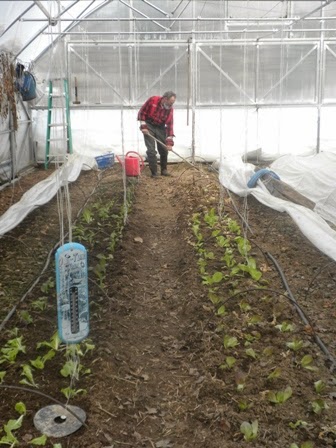Ken has been planting many full season crops that he will transplant later as it warms - onions, tomatoes, peppers, and more.
And of course, Ken is planting greens for winter harvest right along. We remain patient as we hope the weather is good for people making maple syrup and the snow melts slowly enough to go into the soil rather than run off and flood.
From the Kitchen. This time of year I think about featuring local food as we can eat locally all year. So what do I do? Here is one example - local lamb with parsley, potatoes with lamb gravy, and carrots with frozen peas.
And on the side a micro green salad .
This time of year I serve squash cooked kinpira style. this is a Japanese way to cook various seasonal vegetables. The squash today would work wonderfully for that. Here is a link to where I describe the steps using summer vegetables. In place of pepper and eggplant use thin crescent moon shaped pieces of squash. Just a bit of practise and you will have a new tool in your cooking toolbox!
Kinpira
Start with a cast iron or heavy skillet. Toast some sesame seeds and set aside. Use a cooking fat or oil that can take heat, and add some dried hot red pepper flakes if desired. Add the vegetable that takes the longer cooking time (gobo in spring and green peppers in summer). Cook over high heat, and keep stirring. Add the second vegetable. Cook to al dente. Add a teaspoon to tablespoon of sugar, Stir to caramelize, but don't burn. Add a splash at a time of a sweet cooking wine like Japanese mirin or sherry. I use homemade parsnip wine. Finally add some good quality tamari or soy sauce. Top with the toasted sesame seeds and serve.
The sequence is important as the sugar and sweet wine seal in the flavors. Experiment as everyone seems to like a different ratio - some like it hotter, others like it sweeter or saltier. The end result is a toasted sweet, salty glazed vegetable with a bit of crunch. Delicious!







No comments:
Post a Comment